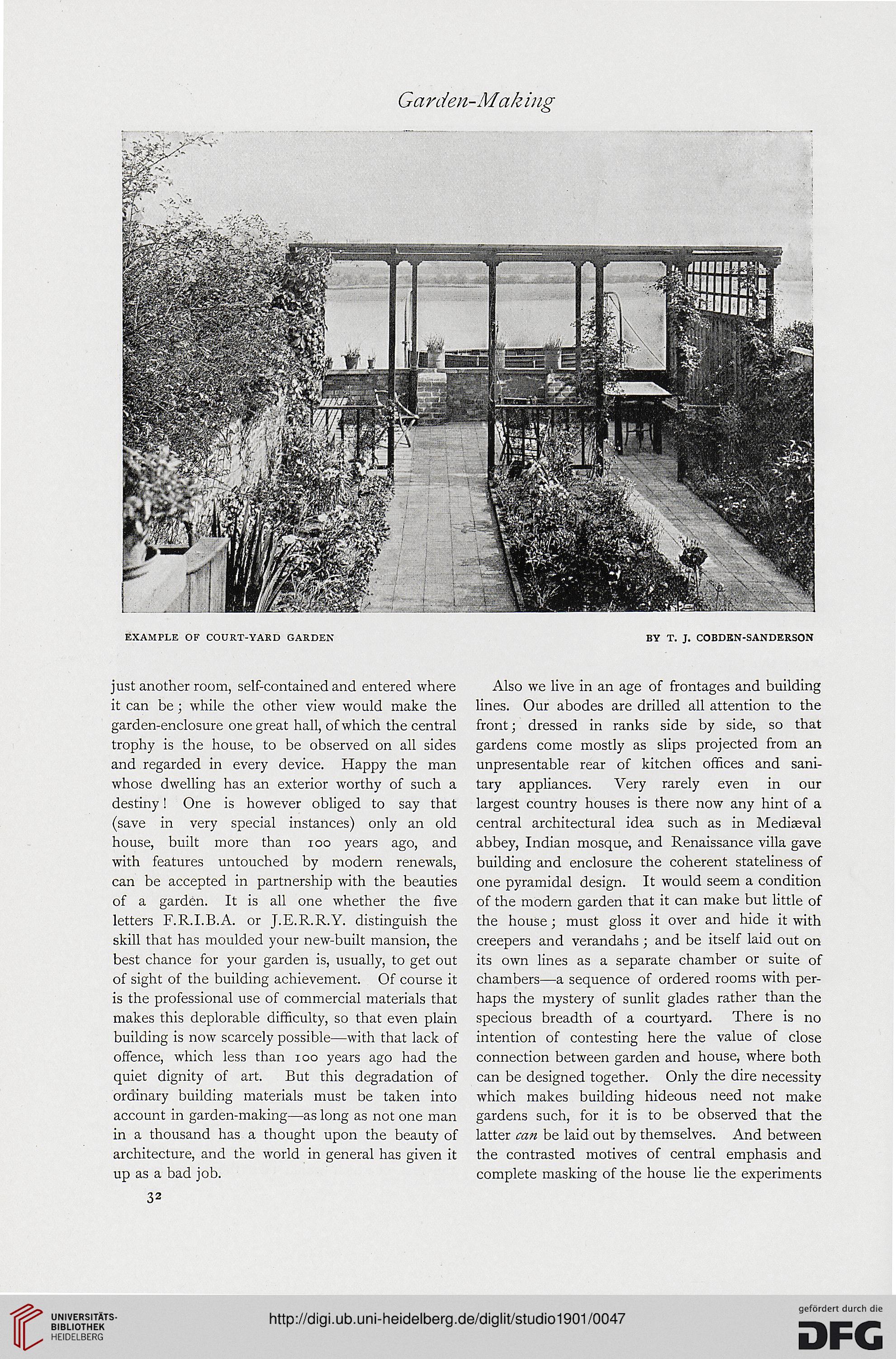Garden-Making
just another room, self-contained and entered where
it can be ; while the other view would make the
garden-enclosure one great hall, of which the central
trophy is the house, to be observed on all sides
and regarded in every device. Happy the man
whose dwelling has an exterior worthy of such a
destiny! One is however obliged to say that
(save in very special instances) only an old
house, built more than 100 years ago, and
with features untouched by modern renewals,
can be accepted in partnership with the beauties
of a garden. It is all one whether the five
letters F.R.I.B.A. or J.E.R.R.Y. distinguish the
skill that has moulded your new-built mansion, the
best chance for your garden is, usually, to get out
of sight of the building achievement. Of course it
is the professional use of commercial materials that
makes this deplorable difficulty, so that even plain
building is now scarcely possible—with that lack of
offence, which less than 100 years ago had the
quiet dignity of art. But this degradation of
ordinary building materials must be taken into
account in garden-making—as long as not one man
in a thousand has a thought upon the beauty of
architecture, and the world in general has given it
up as a bad job.
32
Also we live in an age of frontages and building
lines. Our abodes are drilled all attention to the
front; dressed in ranks side by side, so that
gardens come mostly as slips projected from an
unpresentable rear of kitchen offices and sani-
tary appliances. Very rarely even in our
largest country houses is there now any hint of a
central architectural idea such as in Mediaeval
abbey, Indian mosque, and Renaissance villa gave
building and enclosure the coherent stateliness of
one pyramidal design. It would seem a condition
of the modern garden that it can make but little of
the house; must gloss it over and hide it with
creepers and verandahs ; and be itself laid out on
its own lines as a separate chamber or suite of
chambers—a sequence of ordered rooms with per-
haps the mystery of sunlit glades rather than the
specious breadth of a courtyard. There is no
intention of contesting here the value of close
connection between garden and house, where both
can be designed together. Only the dire necessity
which makes building hideous need not make
gardens such, for it is to be observed that the
latter can be laid out by themselves. And between
the contrasted motives of central emphasis and
complete masking of the house lie the experiments
just another room, self-contained and entered where
it can be ; while the other view would make the
garden-enclosure one great hall, of which the central
trophy is the house, to be observed on all sides
and regarded in every device. Happy the man
whose dwelling has an exterior worthy of such a
destiny! One is however obliged to say that
(save in very special instances) only an old
house, built more than 100 years ago, and
with features untouched by modern renewals,
can be accepted in partnership with the beauties
of a garden. It is all one whether the five
letters F.R.I.B.A. or J.E.R.R.Y. distinguish the
skill that has moulded your new-built mansion, the
best chance for your garden is, usually, to get out
of sight of the building achievement. Of course it
is the professional use of commercial materials that
makes this deplorable difficulty, so that even plain
building is now scarcely possible—with that lack of
offence, which less than 100 years ago had the
quiet dignity of art. But this degradation of
ordinary building materials must be taken into
account in garden-making—as long as not one man
in a thousand has a thought upon the beauty of
architecture, and the world in general has given it
up as a bad job.
32
Also we live in an age of frontages and building
lines. Our abodes are drilled all attention to the
front; dressed in ranks side by side, so that
gardens come mostly as slips projected from an
unpresentable rear of kitchen offices and sani-
tary appliances. Very rarely even in our
largest country houses is there now any hint of a
central architectural idea such as in Mediaeval
abbey, Indian mosque, and Renaissance villa gave
building and enclosure the coherent stateliness of
one pyramidal design. It would seem a condition
of the modern garden that it can make but little of
the house; must gloss it over and hide it with
creepers and verandahs ; and be itself laid out on
its own lines as a separate chamber or suite of
chambers—a sequence of ordered rooms with per-
haps the mystery of sunlit glades rather than the
specious breadth of a courtyard. There is no
intention of contesting here the value of close
connection between garden and house, where both
can be designed together. Only the dire necessity
which makes building hideous need not make
gardens such, for it is to be observed that the
latter can be laid out by themselves. And between
the contrasted motives of central emphasis and
complete masking of the house lie the experiments




